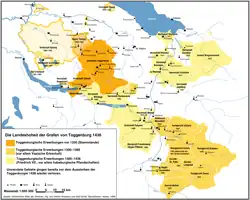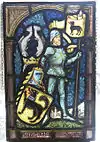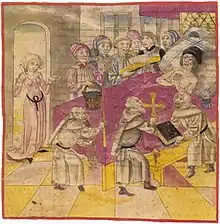County of Toggenburg Grafschaft Toggenburg | |||||||||||||||
|---|---|---|---|---|---|---|---|---|---|---|---|---|---|---|---|
| 1209–1436 | |||||||||||||||
 Territories held by the counts of Toggenburg | |||||||||||||||
| Status | County | ||||||||||||||
| Capital | Lichtensteig | ||||||||||||||
| Government | County | ||||||||||||||
| Historical era | Middle Ages | ||||||||||||||
• first mention | 1209 | ||||||||||||||
| 1394 | |||||||||||||||
• Comital line extinct | 1436 | ||||||||||||||
• Sold to the Abbot of St Gall | 1468 | ||||||||||||||
| |||||||||||||||
The counts of Toggenburg (Grafen von Toggenburg) ruled the Toggenburg region of today's canton of St. Gallen, Switzerland, and adjacent areas during the 13th to 15th centuries.
A baronial family of Toggenburg is mentioned in the 11th and 12th centuries, but their genealogical connection to the comital family is unclear. They are named for their ancestral seat, now known as Alt-Toggenburg, near Kirchberg, St. Gallen. The castle was built in the 10th or 11th century, and was destroyed in 1085 in a conflict with the Abbot of St. Gallen, later rebuilt and in 1226 given to St. Gallen Abbey by count Diethelm of Toggenburg.
The family is attested from the early 13th century, as Toccanburg, later Tochimburc. Diethelm I (possible mention 1176, died 1205 or 1207) was followed by Diethelm II (possible mention 1210, died c. 1230). Either of these was the beneficiary of the inheritance of a number of local noble families (among these Alt-Rapperswil) in c. 1200 and adopted the title of comes (count) from 1209. In 1187, one Werner of Toggenburg became abbot of Einsiedeln. The legend of a Saint Ida of Toggenburg is recorded in 1481, making her the wife of a count of Toggenburg, possibly either Diethelm, or one Heinrich. According to the legend, the husband defenestrated his innocent wife on suspicion of adultery. She survived and lived as an anchoress in Fischingen. Her veneration there is attested for 1410.
The early counts were in competition with St. Gallen Abbey, the bishops of Constance and the counts of Kyburg. The inheritance disputes motivated the donation of religious establishments in Bubikon, Rüti, Oberbollingen and Wurmsbach in the 1190s, and a fratricide by one Diethelm (fl. 1209–36) of his brother Rudolf in 1226.
On 23 April 1398 Count Donat von Toggenburg donated the church of Elsow as benefice for the new Allerheiligenaltar at the grave of the Toggenburg family, for the "salvation of the soul of his daughter Menta von Toggenburg" who had died shortly before.[2] Count Fridrich von Toggenburg, Herr zu Brettengow und Tafas donated to "his own and the salvation of his ancestors who were buried" (at the Rüti church) "and where he also expects to be buried," the church, rights and lands (Kirchwidem and Kirchensatz) in Wangen in der March to the Rüti Abbey, sealed by Fridrich and the knights Herman von Landenberg, Johans von Bonstetten from Ustra and Herman von der Hochenlandenberg on 21 January 1407.[3]
In 1436, the death of the last count, Frederick VII, Count of Toggenburg, led to the Old Zurich War over the succession. Friedrich VII was later buried in a chapel, the so-called Toggenburger Kapelle (capella nova in latere monasterii de novo construxit) given by his noble wife, Elisabeth Countess of Toggenburg, née von Mätsch.[4][5] Elisabeth spent her last days in the Rüti Abbey, writing on 20 June 1442 that she had retreated there (unser wesen gentzlich in dasselbe gotzhus got zuo dienende gezogen habe) and desired her tomb to be with her husband's.[6] On 11 June 1443 marauding troops of the Old Swiss Confederacy devastated the monastery and desecrated the bodies of the nobles, including Count Friedrich VII whom they held responsible for the war with Zürich. 14 members of the family were buried in the Toggenburg vault in the church of the Rüti Abbey.
List of counts
House of Toggenburg
| Ruler | Born | Reign | Death | Ruling part | Consort | Notes | |
|---|---|---|---|---|---|---|---|
| Diethelm I | ? | fl.1044[7] | ? | Lordship of Toggenburg | Unknown at least two children |
First documented lord of Toggenburg,[7] probably the founder of the family. | |
| Berthold | ? Son of Diethelm I |
fl.1044[7] | ? | Lordship of Toggenburg | Unknown | Probably brothers, confirm the same document as their father.[7] It's not known if he succeeded him, or if the succession went through his brother Ulrich. | |
| Ulrich | ? Son of Diethelm I |
? | Lordship of Toggenburg | Unknown | |||
| Fulknand | ? Son of Ulrich or Fulknand |
?-1081 | 1081[8] | Lordship of Toggenburg | Unknown | Probably brothers, it's not known which one succeeded the previous count. It's probable, however, that these belonged to the next generation. There's also an unnamed Toggenburg belonging to Fulknand and Diethelm II's generation, who married a woman named Irmgard (died in January of known year).[9] | |
| Diethelm II | ? Son of Ulrich or Fulknand |
1081-1102? | After 14 July 1102[10] | Lordship of Toggenburg | Unknown | ||
| Diethelm III | ? Son of Diethelm II |
c.1102-c.1146 | c.1146[11] | Lordship of Toggenburg | Unknown | Has a known sister, Kunigunde, who married a nobleman from the Stühlingen family.[11] | |
| Diethelm IV | ? Son of Diethelm III |
c.1146-1176? | c.1176[12] | Lordship of Toggenburg | Ita of Thierstein[13] (Saint Ida of Toggenburg?) (d. 19 August 1200/1226?) one child |
||
| Diethelm V | _tomb.jpg.webp) |
c.1140 Son of Diethelm IV (and Ita?) |
c.1176-1207[14] | 4 January 1205 or 5 January 1207[15] aged ar.64-67 |
Lordship of Toggenburg | Ita?[16] (of Kirchberg?) (Saint Ida of Toggenburg?) one/two children |
Gave an important donation to Ritterhaus Bubikon c.1192. He was buried there and is also represented there in a fresco with his family. |
| Diethelm I the Elder |  |
c.1160 First son of Diethelm V (and Ita of Kirchberg?) |
c.1207-1209[14] | 1230 aged ar.69-70 |
Lordship of Toggenburg | Guta of Rapperswil[17] (Saint Ida of Toggenburg?) (1170-24 November 1227 or after 1227) before or c.1209 three children |
Probably ruled jointly. Diethelm was numbered VI as lord. In 1209 the brothers were raised to counts. After Frederick's assassination, Diethelm rule alone. |
| 1209-1230[14] | County of Toggenburg | ||||||
| Frederick I |  |
c.1160 Second son of Diethelm V (and Ita?) |
c.1207-1209[14] | c.1217[18] aged ar.53-54 |
Lordship of Toggenburg | Unmarried | |
| 1209-1217[14] | County of Toggenburg | ||||||
| Diethelm II the Younger | 1209 Son of Diethelm I and Guta of Rapperswil |
1230 - 25 January 1235[14] | 25 January 1235[19] aged 25-26 |
County of Toggenburg | Gertrude of Neuchâtel c.1220 or January 1221 nine children |
||
| Frederick II | c.1220 Son of Diethelm II and Gertrude of Neuchâtel |
25 January 1235 - 28 April 1284[14] | 28 April 1284 aged ar.63-64 |
County of Toggenburg | Unmarried | Frederick, Diethelm and Kraft ruled jointly as sons of Diethelm II. After Kraft's death, he was replaced in the co-rulership with the former's two eldest sons, Diethelm and Kraft II. | |
| Kraft I | 1228 Son of Diethelm II and Gertrude of Neuchâtel |
25 January 1235 - 15 July 1249/54[14] | 15 July 1249 or 1254[20] aged ar.21-26 |
County of Toggenburg | Elisabeth of Bussnang (d. after 13 January 1277)[21] three children | ||
| Diethelm III | c.1220 Son of Diethelm II and Gertrude of Neuchâtel |
25 January 1235 - 4 September 1248[14] | 4 September 1248 aged ar.27-28 |
County of Toggenburg | Elisabeth c.1247 (before October) no children | ||
| Diethelm IV | c.1240? Son of Kraft I and Elisabeth of Bussnang |
1249-1282/3[14] | After 23 April 1282[22] or 1283 aged ar.41-42 |
County of Toggenburg | Unmarried | ||
| Kraft II the Minstrel |  |
c.1240? Son of Kraft I and Elisabeth of Bussnang |
1249-1261[14] | 1261 aged ar.20-21 |
County of Toggenburg | Unmarried | |
| Frederick III | 1244? Son of Kraft I and Elisabeth of Bussnang |
28 April 1284-1305/9[14] | 7 December 1305 or 17 January 1309[23] aged ar.59-65 |
County of Toggenburg | Clementia of Werdenberg (1246-28 February 1282)[24] five children |
||
| Kraft III | c.1280? Son of Frederick III and Clementia of Werdenberg |
1305/9 - 7 March 1339[14] | 7 March 1339[25] aged ar.58-59 |
County of Toggenburg | Unmarried | Children of Frederick III, ruled jointly. | |
| Frederick IV the Younger[26] | c.1280 Son of Frederick III and Clementia of Werdenberg |
1305/9 - 15 November 1315[14] | 15 November 1315[27][28] Morgarten aged ar.34-35 |
County of Toggenburg | Ida of Frohburg-Homberg (d.19 March 1316/28[29]) five children | ||
| Diethelm V | c.1300? Son of Frederick IV and Ida of Frohburg-Homberg |
15 November 1315 - 21 September 1337[14] | 21 September 1337 Grinau aged ar.36-37 |
County of Toggenburg | Adelaide of Griesenberg (d.1371) two children |
Children of Frederick IV, ruled jointly[27] and with their uncle Kraft III until the latter's death in 1339[30] | |
| Frederick V [31] |  |
c.1300? Son of Frederick IV and Ida of Frohburg-Homberg |
15 November 1315 - 5 February 1364[14] | 5 February 1364[32] aged ar.63-64 |
County of Toggenburg | Kunigunde of Vaz (1308 - February 1364)[33] 23 April 1337 ten children | |
| Donat [2][14][34] | 1358 Son of Frederick V and Kunigunde of Vaz |
5 February 1364 - 7 November 1400[14] | 7 November 1400[35] aged 41-42 |
County of Toggenburg | Agnes of Habsburg-Laufenburg (1387-1425)[36] two children |
Sons of Frederick V, ruled jointly. | |
| Diethelm VI [37] | 1353 Son of Frederick V and Kunigunde of Vaz |
5 February 1364 - 27 December 1385[14] | 27 December 1385 aged 31-32 |
County of Toggenburg | Katharina of Werdenberg-Heiligenberg (1355-30 June 1395)[38] three children | ||
| Frederick VI | 1349 Son of Frederick V and Kunigunde of Vaz |
5 February 1364 - January/May 1375[14] | 22 January/28 May 1375 aged 25-26 |
County of Toggenburg | Unmarried | ||
| Frederick VII |  |
c.1380 Son of Diethelm VI and Katharina of Werdenberg-Heiligenberg |
7 November 1400 - 30 April 1436[14] | 30 April 1436[39] Feldkirch aged 55-56 |
County of Toggenburg | c.1410-30 three children |
After his death, and with no surviving children, he left his wife as his heir. |
| Elisabeth of Mätsch |  |
c.1370 Daughter of Ulrich IV, Lord of Mätsch and Agnes of Kirchberg |
30 April 1436 - 24 November 1446 | 24 November 1446[14] aged 75-76 |
County of Toggenburg | Widow and heiress of Frederick VII. | |
References
- 1 2 The house of Toggenburg used two coats of arms. The older one, used throughout the 13th century but falling out of use after 1308, shows a lion and an eagle party per pale. This is the coat of arms shown in the donor portrait of Bubikon Commandery, dated 1192. The younger coat of arms shows a hound with a wolf collar. This is the coat of arms shown in Codex Manesse, and is used by the bailiwick and reeves of Toggenburg after the extinction of the comital line.
- 1 2 "C II 16, Nr. 215 Graf Donat von Toggenburg, Herr zu Brettengow und Tavas, hat den Kirchensatz von Elsow dem Abt und Konvent des Prämonstr... (1398.04.23)" (in German). Staatsarchiv des Kantons Zürich. Archived from the original on 2022-06-26. Retrieved 2015-08-14.
- ↑ "C II 12, Nr. 277 Graf Fridrich von Toggenburg, Herr zu Brettengow und Tafas, schenkt zum eigenen Seelenheil und dem seiner Vorfahren dem ... (1407.01.21)" (in German). Staatsarchiv des Kantons Zürich. Archived from the original on 2022-06-26. Retrieved 2015-08-14.
- ↑ "Summarium Amt S, Band 1, Seite 10" (in German). Klosterarchiv Einsiedeln. Retrieved 2015-07-31.
- ↑ "A 142.4, Nr. 9 Stiftung einer Messe am Altar einer Kapelle des Klosters Rüti durch Gräfin Elisabeth von Toggenburg, 1439.09.05 (Dokument)" (in German). Staatsarchiv des Kantons Zürich. Archived from the original on 2023-05-30. Retrieved 2015-08-02.
- ↑ "C II 12, Nr. 407 Gräfin Elizabeth von Toggemburg geborene von Maetsch, Witwe, - deren [im Jahr 1436] verstorbener Mann Graf Ffriedrich vo... (1442.06.20)" (in German). Staatsarchiv des Kantons Zürich. Archived from the original on 2022-06-26. Retrieved 2015-08-10.
- 1 2 3 4 Urkundenbuch Zürich, Band I (1888), 233, p. 125.
- ↑ Casuum Sancti Galli Cont. II, Cap. 7, MGH SS II, p. 158.
- ↑ Wyss, Ex Libro Vitæ Einsidlensi [Liber Heremi] (1885), p. 345.
- ↑ Quellen zur Schweizer Geschichte (Basel, 1881), Band III, 39, p. 65.
- 1 2 Württembergisches Urkundenbuch II, CCCXXIII, p. 38.
- ↑ Regesta Episcoporum Constantiensium, Band I (Innsbruck, 1895), 1038, p. 116.
- ↑ Cod Giessensis Nr. 176, fol. 234, included as Genealogiæ Comitum et Marchionum sæc XII et XIII, in MGH SS XXIV, p. 78.
- 1 2 3 4 5 6 7 8 9 10 11 12 13 14 15 16 17 18 19 20 21 22 Toggenburg (S.G.) in German, French and Italian in the online Historical Dictionary of Switzerland.
- ↑ Urkundenbuch Zürich, Band I (1888), p. 235.
- ↑ Cod Giessensis Nr. 176, fol. 234, included as Genealogiæ Comitum et Marchionum sæc XII et XIII, in MGH SS XXIV, p. 78.
- ↑ Sankt-Gallen Urkundenbuch, Teil III, 842, p. 58.
- ↑ Urkundenbuch Zürich, Band I (1888), 383, p. 269.
- ↑ Sankt-Gallen Urkundenbuch, Teil III, 871, p. 85.
- ↑ Bern Urkunden, Band I, p. 464.
- ↑ Pupikofer, J. A. (1828) Geschichte des Thurgaus, Erste Hälfte (Zürich), Urkunden, 12, p. 20.
- ↑ Herrgott (1737), Vol. III, DCV, p. 504
- ↑ Still living in 1303, according to Urkundenbuch Landschaft Basel (1881), Vol. 1, no. 158.
- ↑ Clementia von Montfort
- ↑ MGH, Necrologia Germaniæ, Band I, p. 558.
- ↑ Friedrich IV, Graf von Toggenburg
- 1 2 Frederick IV was dead by 1319, according to Sankt-Gallen Urkundenbuch, Teil III, 1251, p. 412.
- ↑ Scherrer, G. (1874) Kleine Toggenburger Chroniken (St. Gallen), p. 2.
- ↑ MGH, Necrologia Germaniæ, Band I, p. 540.
- ↑ Sankt-Gallen Urkundenbuch, Teil III, 1251, p. 412.
- ↑ Friedrich V, Graf von Toggenburg
- ↑ Last charter dated 22 March 1363. Date of death proposed at Cur-Rätiens Urkunden, Band III (1858), 107, p. 166.
- ↑ Kunigunde von Vaz
- ↑ Donat von Toggenburg
- ↑ MGH, Necrologia Germaniæ, Band I, p. 453.
- ↑ Agnes von Habsburg-Laufenburg
- ↑ Diethelm VI, Graf von Toggenburg
- ↑ Katharina von Werdenberg-Heilingenberg
- ↑ By 28 September of that year, he was already dead, according to Bergmann, J. ‘Urkunden der vier vorarlbergischen Herrschaftern und der Grafen von Montfort’, Archiv für Kunde österreichischen Geschichts-Quellen, Band I (Vienna, 1848) (“Bergmann ‘Grafen von Montfort’ (1848)”), Heft IV, LXIX, p. 25.

